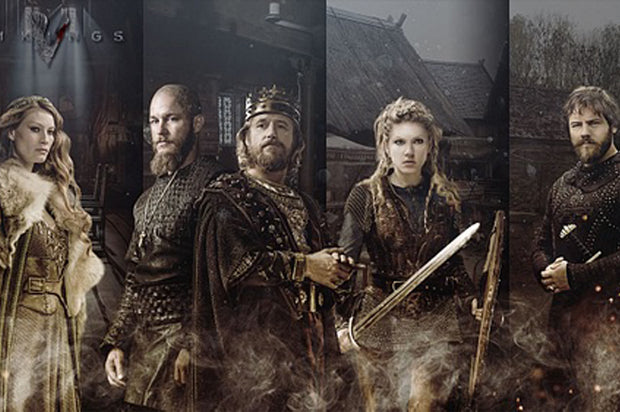History Of The Vikings - Chapter 2
The Vikings and The English
The Vikings were known for being merciless and fearless warriors who plundered near and far, taking what they needed and killing anyone who stood in their path. But while some believed the reason for their invincibility was Odin's divine intervention there were more logical reasons for their success.
Their homeland was Scandinavia and they had to travel great distances as far as England, North America and even Russia to be able to raid and conquer new land. Mostly through sea. But to set the record straight, not all Viking raids were successful. Some battles were won, and some lost with great casualties on all sides. There are many accounts of the losses incurred by the Vikings especially in their quest to conquer England. The Viking saga speaks of three key battles. And while the first Viking raid of 793 against a monastery in St. Cuthbert on Lindisfarne was a sign of things to come, this was not how it all began. The Viking quest to invade England started upon the death of famous Danish king, Ragnar Lothbrook, in the hands of Aella, King of Northumbria. Ragnar's sons Ivar, Ubba and Halfdan led the "Great Heathen Army" upon the Northumbria army and later on, in time, the whole of England. But while the Vikings were known for their skills in warfare and hand to hand combat, it was not fated that they occupy English land.
Ivar's army was first to arrive in East Anglia in 865. It was a quick victory as the locals of East Angalians were easily subdued and surrendered. They offered the Vikings treasure, shelter, food and horses. In exchange, the Vikings would not raid their lands. This arrangement suited Ivar well as he still needed to wait for his brothers to arrive with reinforcements. In late autumn of 866AD, Ivar and his forces marched North. They took the Northumbrian forces in York by surprise as it was not customary to battle during the winter. Another quick victory.
It was only the following spring when Osbert and Aella (Ragnar's killer) joined forces to evict Ivar and his countrymen. They wanted to claim the throne of Northumbria for themselves and needed the Vikings gone. This was to be Ivar's first win. While the Vikings were only a handful, they were known to be skilled warriors and Ivar an intelligent tactician. What the Northumbrians had in numbers, the Vikings more than made up for in skills and brute force. The Vikings used the tight streets of York to their advantage and defeated Osbert and Aella's army. This was to be called, "The Battle of York".
But while their victory was sweet it was short lived. Towards the end of 870, Ivar and the Great Heathen Army had control over Northumbria and East Anglia. Wanting more, Ivar seized the town of Reading and transformed it into his base. From there he began his conquest of Wessex. His brother, Halfdan, along with Bagsecg, another Viking chieftain, decided to raid the banks of Kennet. However, they were engaged into battle by Ealdorman Aethelwulf who was out to defend his country. This was to be the first Viking loss and the first English victory.

Between 871-899, King Alfred ruled England, after defeating the Vikings at the Battle of Edington. This was in 878 AD, when Gunthrum went against the treaty he and King Alfred signed, launching a surprise attack. Chippenham, Alfred's home, fell. Forced into hiding, Alfred and his family took refuge in Somerset where he rebuilt his army. News of this spread and many Wessex lords and ordinary men went to war with him and together they defeated Guthrum's army in a bloody battle meant to secure England. The battle was fought in the village of Edington, and rightly called, this was the Battle of Edington. Guthrum's defeat resulted in his conversion to Christianity. On 886, King Alfred took London from the Vikings and fortified it. It was also in the year 886 that he again signed a peace treaty with Guthrum, this time partitioning England between the English and the Vikings. The Viking territory comprised the north west, the north east and the east of England while King Alfred claimed the rest. The Viking territory became known as Danelaw. Hence, the Danes.
After the passing of King Alfred, his grandson, Athelstan, took reign. Like his grandfather before him, he also led the English to victory against the Vikings. In 937, he led them to the Battle of Brunaburh. In 954, Eirik Bloodaxe was killed in battle. He was the last Viking king of York. Upon his passing, the English took reign and for the first time since the division of England, the English once again had full control.
This resulted in England having four kings with Viking descent between 1013 and 1042. The greatest being King Cnut. However, as he was raised Christian despite his Viking heritage, he did not enforce upon the Vikings the English way of life. Instead he recognized their customs and laws. His vision was to create an empire that united both the English and the Scandinavians. Unfortunately, this did not happen. King Cnut died at the young age of 39 and try as they might his sons were not as successful in their effort to unite both kingdoms.
The final Viking invasion came in 1066. Harald Hardrada sailed the River Humber and marched to Stamford Bridge carrying his battle banner, "Land-waster". Harold Godwinson, then the king of England, marched north with his army and defeated the Vikings in a long and bloody battle. With no time to rest, King Harold then proceeded to march his army south after hearing that William of Normandy had landed in Kent with plans of invasion. Battle weary and exhausted, King Harold and his men fought bravely but in the end were defeated at the Battle of Hastings on October 14, 1066. With the victory of the Normans and the death of King Harold, William of Normandy was the new English king. Ironically, William's success can also be attributed to his Viking heritage. While he and his people were mostly French, his great-great-great grandfather was Rollo, a Viking who invaded Normandy in 911.
You'd think this would be the end of the Viking raids, however, even after their loss in 793 different Viking bands still made regular raiding voyages for over 300 years. This time around the coasts of Britain. One such raid was in 991, when the Vikings led by Olaf Tryggvason defeated the Anglo-Saxon's under the reign of Æthelred 'the Unready'. There was retaliation, of course, as the Anglo Saxons fought to defeat the Vikings and gain back their honor.
The Viking age ended over time as Vikings slowly started settling around Europe. Either they conquered the land or pledged their loyalty to local rulers. One such Viking was Rollo who invaded Normandy in 911 and never left. Years later in 1066 CE, his great great great grandson William would then be known to conquer England. For 250 years, the Vikings raided and invaded Europe, however, after that they never returned.
Viking Ships
Much of the success of Viking conquest and trade, can easily be attributed to their skills in the battlefield and the innovative design of their ships. In the year 1000, a Viking crew led by Leif Erikson first staked their claim of North America. That's 500 years before Christopher Columbus made his discovery.
The Vikings made different kinds of ships depending on the need. Smaller boats were made for fishing and bigger boats for trade or longer trips at sea. Perhaps the most iconic and effective being the LONGSHIP. They were long, narrow and flat in design to ensure speed and durability. They were meant to endure stormy weather but still be light enough to be carried to land. As Viking vessels do not have shelter, the ships needed to be brought to shore so they could set up tents and sleep through the night. If they were too far off at sea, they would sleep on deck using animal skins for blankets. The design of the longship has evolved over time dating back to the Stone Age with the invention of the umiak. With a top speed of 17 knots, the longship could even navigate through shallow waters. Much of this can be credited to the "clinker" method of design where timber or oak overlapped and were nailed together. Tarred wool and animal hair were then used to fill the spaces between planks. This ensured a watertight ship. The prow or the front of the ship was often decorated with a carving of an animal head. Popular featured figureheads were that of a snake or a dragon, meant to scare of evil spirits. There are four known types of longships: Karvi, Snekkja, Drakkar and Skeid. The longest longship ever recovered was the Skuldelev 2 and is approximately 30 meters. It was discovered between 1996 to 1997 in Denmark. Other known longships would be the Oseberg ship and the Gokstad ship both discovered in Norway and the Nydam ship a burial ship discovered in Denmark.

In 1970, 11th century Viking ships were recovered in Denmark. This led to the discovery that there were two different classes of ships during the Viking Era: the Langskip and the Knarr.
Langskips were built for speed and maneuverability which comes in handy during sea battles. They are completely open and have minimal decking. They also have removal planks under the rowers laid on the cross beams. Warships had single squared rigged sail. This allows being able to sail close to the wind, which combined with the capability to row during difficult wind conditions, made engaging and retreating in enemy territory much easier. Warships were an extravagance during the Viking era as it gave its owners added prestige and the prospect of victory for future battles. Construction was expensive and took time. As such during battle the intent was to overpower the crew and gain control of the vessel all the while making sure not to damage or sink it.
Knarr's or merchant ships, in contrast, were partially enclosed and powered primarily by sail. The primary concern when building Knarr vessels would be ensuring the safety of the cargo. They averaged in length of about 16m and had the capacity of carrying up to 122 tons. The Knarr was intended for longer voyages in the Atlantic and was capable of sailing 121 km in one day. It can hold a crew of about 20-30 and was often used to carry livestock and merchandise. Knarr's would often cross the North Atlantic carrying precious cargo such as sheep, horses, armour, honey, weapon and sometimes even slaves. They would cross Norse settlements in Greenland and Iceland. In 1993, the Äskekärr ship was discovered in Sweden and is by far the best preserved Knarr to date.
To give emphasis to just how invaluable these vessels could be, an old Viking custom was to bury their dead chieftains together with their ships. The Vikings firmly believed that their dead was meant to sail to the afterlife thus burying them along with their vessel. They would dress them in their best clothes and after much preparation, the body would be transported to the burial place in a wagon drawn by horses. This is an ancient tradition dating back to 200 AD.




Dejar un comentario